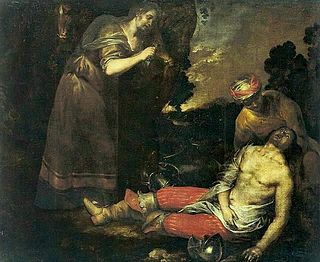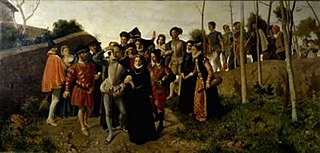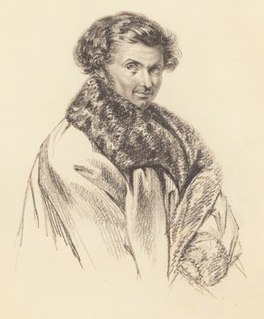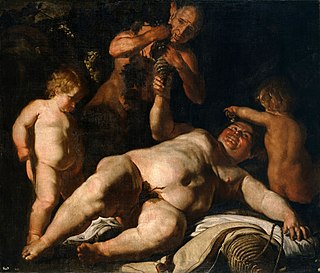Related Research Articles
Sebastiano Filippi was an Italian late Renaissance – Mannerist painter of the School of Ferrara.

Camillo Procaccini was an Italian painter. He has been posthumously referred to as the Vasari of Lombardy, for his prolific Mannerist fresco decoration.
Giovanni Battista Barbiani (1593–1650) was an Italian painter of the Baroque period, active in Ravenna. Among his works are altarpieces of St. Andrew and St. Joseph for the Franciscan church. For the dome of the chapel of the Madonna del Sudore in the Cathedral of Ravenna, he painted a fresco of the Assumption of the Virgin. He painted a ' St. Peter' in Sant' Agata in Ravenna. He painted in the style of Bartolomeo Cesi. Along with Cesare Pronti, he painted in the church of San Romualdo (designed by Luca Danesi, of the Camaldolese Abbey, now home to the Biblioteca Classense of Ravenna. The grand corridor in the Abbey is also frescoed by Barbiani with famous benedictine and camaldolese monks. His nephew Andrea Barbiani was also a painter in Ravenna and Rimini.

Luciano Borzone was an Italian painter of a late-Mannerist and early-Baroque styles active mainly in his natal city of Genoa.
Cesare Poggi (1803–1859) was an Italian painter, active in the Neoclassic style of grand manner history depiction, mainly around his native city of Milan. He was a pupil of Luigi Sabatelli, but after 1824 studied in Venice and Rome. He died at Milan, where he became a member of the Academy of Painters.

Carlo Antonio Procaccini was an Italian painter of the late-Renaissance period.

Ercole Procaccini il Giovane was an Italian painter of the Baroque period.
Antonio Bonfanti was an Italian painter. He was also called Il Torricella. He was a native of Ferrara, where he painted a Presentation of Mary at Temple and Dispute among Doctors for the chancel of the church of San Francesco and a Holy Family for the church of La Santissima Trinità. He was a pupil or follower of Guercino. His brother Giulio was also a painter.
Cesare Bernazano was an Italian painter of the Renaissance period. He was born in Milan, and painted still lifes with landscapes, animals, and fruit. The figures in his landscapes are generally painted by Cesare da Sesto. Francesco Vicentino was a pupil of his.

Marco Antonio Bassetti (1586–1630) was an Italian painter.

Cesare Vecellio was an Italian engraver and painter of the Renaissance, active in Venice.
The year 1536 in art involved some significant events and new works.

Bernardo Celentano was an Italian painter of the 19th century, who painted historical themes in the style of Realism.
Cesare and Vincenzo Conti, two brothers, were natives of Ancona, but went to Rome during the Pontificate of Gregory XIII, by whom they were employed. They were also both employed by his successors, Sixtus V, Clement VIII, and Paul V. Cesare was esteemed for his grotesque ornaments, and Vincenzo painted the figures. Cesare died at Macerata about 1615. Vincenzo went on to the court of Savoy, and died there in 1610. Some of their works are in Santa Maria in Trastevere, while in San Spirito in Sassia is the history of San Giacomo del Zucchi, and in Santa Cecilia, 'St. Agnes,' and the 'Martyrdom of St. Urban.'

Johann Christian Michel Ezdorf or Etzdorf (1801–1851), a German landscape painter, was born at Pösneck, in the duchy of Saxe-Meiningen. He studied landscape painting in Munich and its environs, and displayed an especial talent in representing gloomy forests, taking as his models the works of Ruisdael and Van Everdingen. He visited Norway, the North Cape, Sweden, Iceland, and England. One of his best paintings is in the Modern Gallery at Munich; it represents a Forge by the side of a Waterfall. He died at Munich in 1851.

Camillo Filippi was an Italian painter who flourished about the middle of the 16th century.

Cesare Fracanzano (1605-1651), a Neapolitan painter who flourished in the 17th century, was a pupil of Spagnoletto. Born in Bisceglie, in Apulia by Alessandro, a nobleman originally from Verona and a mannerist painter. His pictorial style was based on Ribera, but also on Tintoretto, the Carracci brothers and Guido Reni. After long years of artistic preparation and work in Naples, in 1626 he returned to Apulia, to Barletta where he married Beatrice Covelli. He worked a lot in the Apulian town in churches and noble palaces. He moved from his hometown only to carry out work commitments in Naples, Rome and other places in Apulia. There is in the Museo del Prado (Madrid) a picture by him, representing Two Wrestlers. His son, Michelangelo Fracanzano, who was also a painter, died in France about 1685. His brother Francesco was also a painter.

Francesco Fracanzano (1612–1656) was an Italian painter who participated in the Masaniello rebellion.

Cesare Fracassini was an Italian painter, mainly of large mythologic or religious topics.
Cesare da Conegliano was an Italian painter, known from a single work in Santi Apostoli, Venice.
References
- ↑
 This article incorporates text from a publication now in the public domain : Bryan, Michael (1886). "Filippi, Cesare". In Graves, Robert Edmund (ed.). Bryan's Dictionary of Painters and Engravers (A–K). I (3rd ed.). London: George Bell & Sons.
This article incorporates text from a publication now in the public domain : Bryan, Michael (1886). "Filippi, Cesare". In Graves, Robert Edmund (ed.). Bryan's Dictionary of Painters and Engravers (A–K). I (3rd ed.). London: George Bell & Sons.
| | This article about an Italian painter born in the 16th century is a stub. You can help Wikipedia by expanding it. |